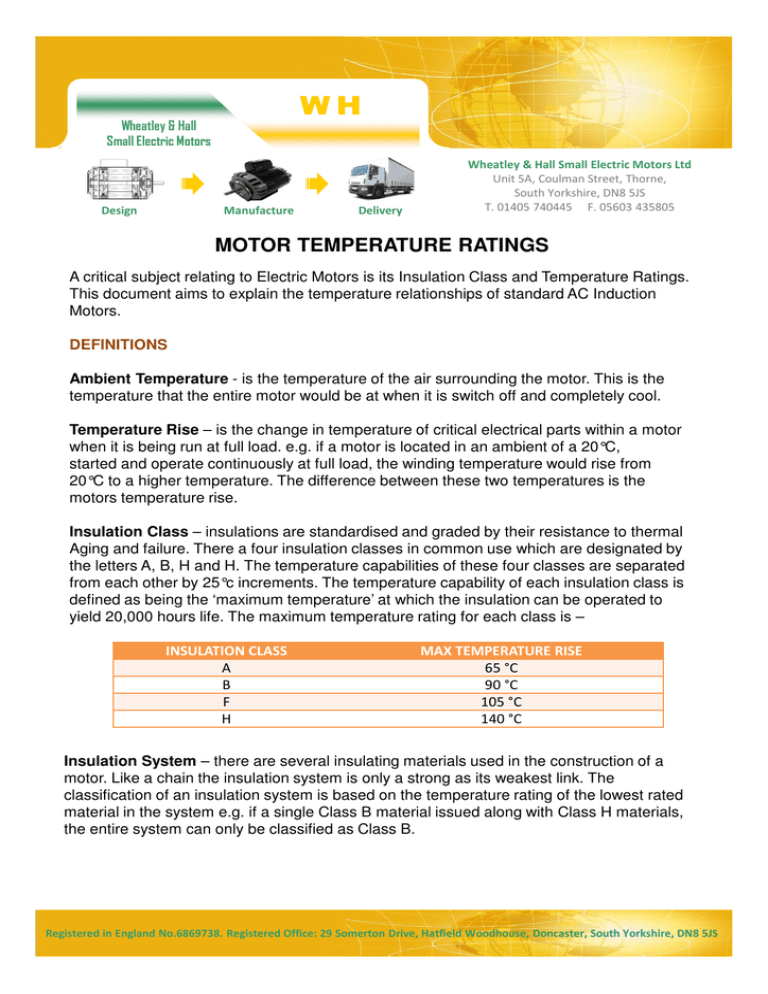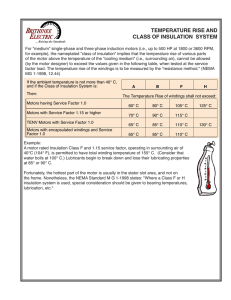motor temperature ratings
advertisement

Wheatley & Hall Small Electric Motors Design Manufacture Delivery Wheatley & Hall Small Electric Motors Ltd Unit 5A, Coulman Street, Thorne, South Yorkshire, DN8 5JS T. 01405 740445 F. 05603 435805 MOTOR TEMPERATURE RATINGS A critical subject relating to Electric Motors is its Insulation Class and Temperature Ratings. This document aims to explain the temperature relationships of standard AC Induction Motors. DEFINITIONS Ambient Temperature - is the temperature of the air surrounding the motor. This is the temperature that the entire motor would be at when it is switch off and completely cool. Temperature Rise – is the change in temperature of critical electrical parts within a motor when it is being run at full load. e.g. if a motor is located in an ambient of a 20°C, started and operate continuously at full load, the winding temperature would rise from 20°C to a higher temperature. The difference between these two temperatures is the motors temperature rise. Insulation Class – insulations are standardised and graded by their resistance to thermal Aging and failure. There a four insulation classes in common use which are designated by the letters A, B, H and H. The temperature capabilities of these four classes are separated from each other by 25°c increments. The temperature capability of each insulation class is defined as being the ‘maximum temperature’ at which the insulation can be operated to yield 20,000 hours life. The maximum temperature rating for each class is – INSULATION CLASS A B F H MAX TEMPERATURE RISE 65 °C 90 °C 105 °C 140 °C Insulation System – there are several insulating materials used in the construction of a motor. Like a chain the insulation system is only a strong as its weakest link. The classification of an insulation system is based on the temperature rating of the lowest rated material in the system e.g. if a single Class B material issued along with Class H materials, the entire system can only be classified as Class B. Registered in England No.6869738. Registered Office: 29 Somerton Drive, Hatfield Woodhouse, Doncaster, South Yorkshire, DN8 5JS Wheatley & Hall Small Electric Motors Design Manufacture Delivery Wheatley & Hall Small Electric Motors Ltd Unit 5A, Coulman Street, Thorne, South Yorkshire, DN8 5JS T. 01405 740445 F. 05603 435805 TEMPERATURE AND MOTOR RATING The base ambient temperature rating point of all electric motors 40°C. This means that a motor, rated for 40°C ambient, is suitable for installation in applications where the normal surrounding are temperature does not exceed 40°C. This is the base point. When the motor is operated at full load, it has a specific temperature rise. The rise is always added to the ambient temperature. For example, a motor designed for Class A insulation and a maximum temperature rise by resistance is 55°C would have a total average winding temperature rise of 40°C (ambient) + 55°C (rise) or 95°C. The 10°C difference between 95°C and 105°C Class A insulation system is used to handle the ‘hot spot allowance’. If you now use the same motor but change the insulation system to Class B, there is an extra 25°C of thermal capability available which can be used handle – Higher than normal ambient temperature Higher than normal temperature rise brought on by overloads Extend the motor life and be more tolerant of overheating factors (high/low voltages, voltage imbalance, blocked ventilation, high inertia loads, high starting frequency, etc.) MOTOR INSULATION IN PRACTICE Over time improvements have been made in insulating materials. In tandem with these improvements come cost reductions. As a result of these changes most motor manufactures use a mixture of materials in the design of their motors, many of which have a higher than required temperature rating. This means that many fractional horsepower motors are design for Class A temperature rise, the practical insulation class can be Class B or higher. As a rule of thumb, insulation life will be doubled for each 10°C of unused insulation temperature capability. The same 10°C rule equally applies to motors operating at above rated temperature. In this case the insulation life is halved for each 10°C of over-temperature. Registered in England No.6869738. Registered Office: 29 Somerton Drive, Hatfield Woodhouse, Doncaster, South Yorkshire, DN8 5JS Wheatley & Hall Small Electric Motors Design Manufacture Delivery Wheatley & Hall Small Electric Motors Ltd Unit 5A, Coulman Street, Thorne, South Yorkshire, DN8 5JS T. 01405 740445 F. 05603 435805 MOTOR SURFACE TEMPERATURE As can be expected motor surface temperature is of concern. The motor surface temperature will never exceed the internal temperature of the motor. This should not be ignored because the motor surface temperature can be high enough to cause human skin to burn (a first degree burn injury occurs at 48°C) when touched. Although high, this temperature does not mean overload or imminent motor failure. SUMMARY One of the main factors in motor life is the insulation system. The key to the insulation and motor life is the maximum temperature that the insulation system experiences and the temperature capabilities of individual insulation components. Registered in England No.6869738. Registered Office: 29 Somerton Drive, Hatfield Woodhouse, Doncaster, South Yorkshire, DN8 5JS

